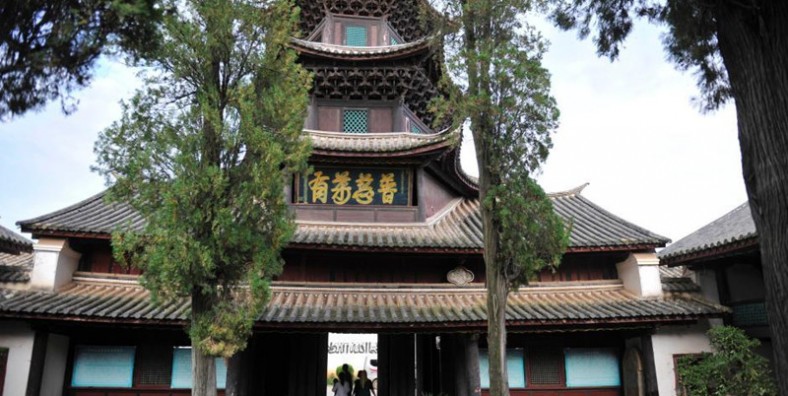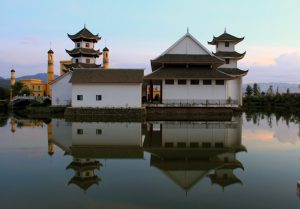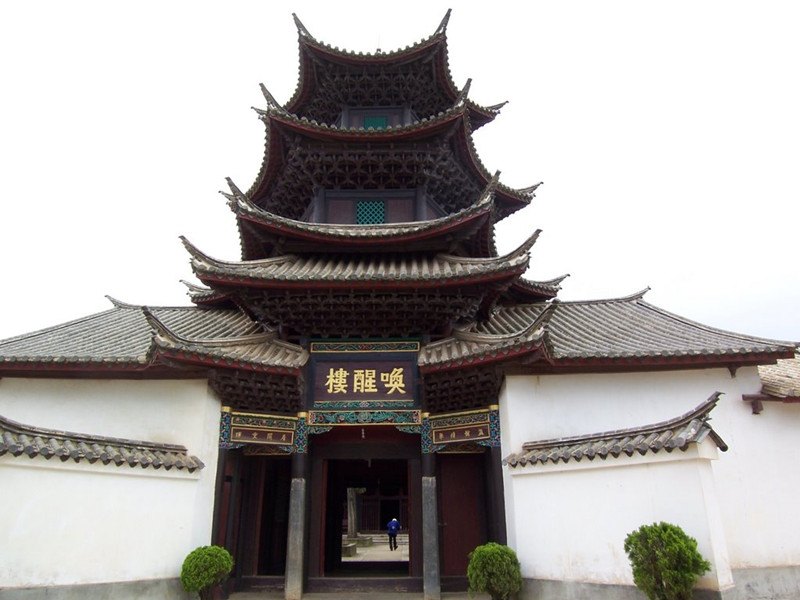
Tuogu Mosque in Ludian County, Zhaotong

Attraction Overview
Built in Yongzheng Period (1722-1735) of Qing Dynasty, Tuogu Mosque is one of the five ancient temples and one of the ten mosques in Yunnan Province. Covering an area of 4,000 square meters, it is located about 10 kilometers east of the county seat of Ludian county.
Chinese Name: 拖姑清真寺(Pinyin: Tuogu Qingzhensi)
Best Time to Visit: All-year-round
Recommended Visiting Time: 2 Hours
Location: Tuogu Village, Taoyuan Muslim Township, Ludian County, Zhaotong City of Yunnan Province
Tuogu Mosque (拖姑清真寺) is located in Tuogu Village (拖姑村), Taoyuan Hui Ethnic Township (桃源回族乡), about 10 kilometers east of Ludian County (鲁甸县), Zhaotong City (昭通市), Yunnan Province (云南省). Originally built in the eighth year of the Yongzheng reign of the Qing Dynasty (1730), the mosque covers an area of 4,000 square meters. It is recognized as a Key Protected Cultural Heritage Site of Yunnan Province and is one of the Five Ancient Mosques of the province, often referred to as the “Ancestral Mosque” (祖寺).

The mosque features a traditional siheyuan (四合院, courtyard-style) layout, consisting of the Main Hall, Awakening Tower (唤醒楼), Wujian Hall (无倦堂), Rear Pavilion, Side Rooms, Water Room, and Shadow Wall. Today, more than 30 rooms remain, with the Main Hall standing 13 meters tall, 18 meters long, and 15 meters wide, supported by 36 round columns and capable of accommodating nearly 300 worshippers.
The Awakening Tower is built without nails, using traditional mortise-and-tenon techniques. Beneath its eaves hangs a plaque from the eleventh year of the Qianlong reign (1746), inscribed by General Ye Dahong (冶大雄), reading “Universal Compassion for All” (普慈万有). A couplet in the mosque vividly captures its architectural beauty: “Layers of brilliance stacked high, flourishing trees offer endless blessings” (层图重辉 华树赠益).
Despite the powerful 6.5-magnitude Ludian earthquake in 2014 and several other strong tremors, the mosque remains intact, a testament to its scientifically sound and expertly crafted construction. The surroundings are serene, with lush fields, winding riverbanks, verdant trees, and rolling hills.
Historical Development
According to inscriptions found within the mosque, Tuogu Mosque (拖姑清真寺) was first built in 1730 (eighth year of the Yongzheng reign), funded by Ma Lincan (马鳞灿) and Ma Linchi (马鳞炽), ancestors of the Ma family who were Qing Dynasty military officers. Due to their meritorious service, they were granted land in the Tuogu region, where they took the lead in constructing the mosque’s Main Hall.
In 2014, despite the severe 6.5-magnitude earthquake in Ludian (鲁甸), the mosque remained completely undamaged.

Scale and Layout
Tuogu Mosque (拖姑清真寺) spans a total area of 4,000 square meters and is recognized as one of the five major ancient mosques in Yunnan Province.
Architectural Features
Architectural Style
The mosque features a traditional courtyard layout composed of the Main Hall, Awakening Tower (唤醒楼), Wujian Hall (无倦堂), Rear Pavilion, Side Rooms, Water Room, and Shadow Wall. With more than 30 structures in total, it is renowned for its unique craftsmanship and long history, earning its place as a provincially protected heritage site.
Main Hall
The Main Hall is the central structure of the mosque. Measuring approximately 13 meters high, 18 meters long, and 15 meters wide, it is supported by 36 round columns. The hall’s interior is majestic, adorned with intricately carved beams and painted rafters. A horizontal plaque inscribed with “Heaven of Joy” (快乐天堂) hangs in the center. The hall accommodates up to 300 worshippers.
Remarkably, two large horizontal beams are supported only by four thin rectangular wooden slats—an impressive feat of engineering. The roof has upturned eaves at each corner, adding to its stately presence.

Awakening Tower (唤醒楼)
The Awakening Tower serves as a symbolic call to prayer and is the most unique and eye-catching structure in the mosque. Inside, large round wooden columns support layer upon layer of beams and rafters. At first glance, the columns appear to reach the roof directly, but in reality, the structure is divided into five layers, with the number of columns decreasing by level: 28 columns each on the first and second floors, 10 on the third and fourth, and only 6 on the fifth.
These columns and beams are interlocked, forming a rectangular base that transitions into a hexagonal upper frame, supporting the three-tiered tiled roof. Remarkably, no iron nails are used throughout the entire structure, fully showcasing the ingenuity and craftsmanship of traditional builders.
On the second floor, facing the Main Hall, a large plaque inscribed with the four flowing characters “Universal Compassion for All” (普慈万有) is hung. It was written in 1746 (eleventh year of Qianlong’s reign) by Ye Dahong (冶大雄), hereditary general and commander of Zhaotong Prefecture (昭通府).
The mosque couplet, “Layers of brilliance stacked high, flourishing trees offer endless blessings” (层图重辉 华树赠益), vividly captures the mosque’s essence and architectural elegance.
Side Rooms
Beyond the Awakening Tower lies a spacious courtyard, flanked by side rooms. These side rooms currently house the mosque’s Ahong (阿匐, religious leader), the Islamic Committee, and classrooms. The courtyard, measuring about 400 square meters, features four lush cypress trees and a golden osmanthus tree. During mid-autumn, its blossoms fill the air with a refreshing fragrance.
Cultural Significance
Tuogu Mosque (拖姑清真寺) stands out among more than a hundred mosques in the Zhaotong (昭通) area. Owing to its long history, it is honored as the “Ancestral Mosque” (祖寺) of Yunnan Province. Its construction is a marvel of traditional craftsmanship—without nails, wedges, or clamps. The structural design is scientifically sound and has withstood centuries of upheaval and several earthquakes without damage. It is truly a masterpiece that inspires awe and admiration.

 7 Days GolfingTour
7 Days GolfingTour
 8 Days Group Tour
8 Days Group Tour
 8 Days Yunnan Tour
8 Days Yunnan Tour
 7 Days Shangri La Hiking
7 Days Shangri La Hiking
 11 Days Yunnan Tour
11 Days Yunnan Tour
 6 Days Yuanyang Terraces
6 Days Yuanyang Terraces
 11 Days Yunnan Tour
11 Days Yunnan Tour
 8 Days South Yunnan
8 Days South Yunnan
 7 Days Tea Tour
7 Days Tea Tour
 8 Days Muslim Tour
8 Days Muslim Tour
 12 Days Self-Driving
12 Days Self-Driving
 4 Days Haba Climbing
4 Days Haba Climbing
 Tiger Leaping Gorge
Tiger Leaping Gorge
 Stone Forest
Stone Forest
 Yunnan-Tibet
Yunnan-Tibet
 Hani Rice Terraces
Hani Rice Terraces
 Kunming
Kunming
 Lijiang
Lijiang
 Shangri-la
Shangri-la
 Dali
Dali
 XishuangBanna
XishuangBanna
 Honghe
Honghe
 Kunming
Kunming
 Lijiang
Lijiang
 Shangri-la
Shangri-la
 Yuanyang Rice Terraces
Yuanyang Rice Terraces
 Nujiang
Nujiang
 XishuangBanna
XishuangBanna
 Spring City Golf
Spring City Golf
 Snow Mountain Golf
Snow Mountain Golf
 Stone Mountain Golf
Stone Mountain Golf

















